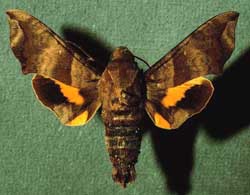Dilophonotini thumbnails
Suriname Dilophonotini:
Aellopos, Eupyrrhoglossum, Nyceryx, Perigonia
This tentative checklist will become more accurate as images and information are sent to me. If you would like
to assist in the development of this worldwide Sphingidae data/image
base, please send info and images to Bill Oehlke.
I have arranged the images in accordance with my perception of wing characters: predominent markings, shape, colour,
size.
There are probably some Suriname species not listed below, and there are many species listed that are not officially confirmed for Suriname, although
I think they have a good chance of being found there.
Females often have a wing shape or pattern that differs from the males. I hope some day to also have a thumbnail checklist for the females.
Eupyrrhoglossum
Eupyrrhoglossum sagra is the only member of its genus
with a presence in French Guiana.
Note white/pale spot/crescent in middle of forewing subterminal area.
Note bright yellow hindwing fringe.
Its markings are beautiful and
distinct.
|

Eupyrrhoglossum sagra
|
|
|
Nyceryx

Nyceryx maxwelli:
Several dark patches against lavender-grey ground colour.
Similar to Nyceryx continua cratera but apex of hindwing upperside brown and
tornal area not yellow. Hindwing upperside with yellow basal area not extending beyond 1A,
and apex brownish-orange (not dark brown).

Nyceryx coffaeae
Almost uniform dark brown ground colour.
Outer margin not deeply hollowed out below apex, instead o.m. divided into two roughly equal, almost straight (slightly concave)
edges with slight bulge at their juncture.
Large, slightly darker trapezoid with base along inner margin, extending to bottom of cell.
|

Nyceryx ericea
Prominent diffuse, dark arc, upwardly convex, from near midpoint of costa to anal angle.
Thin, dark, scalloped arc from apex to anal angle.
Semitransparent spots in the distal half of the forewing.

Nyceryx tacita
Prominent small white triangular patch in upper half of subterminal area.
Strong dark green suffusions over dark brown in costal regions.
Large dark triangular patch with base from body to midpoint along inner margin with right angle to costa.
Significant pale lines define other dark patches.
|

Nyceryx riscus
Diffuse, very dark, somewhat angular arc from apex to anal angle.
Fine but distinct lines over reddish brown ground colour.
Lacks significant addition markings on forewing.

Nyceryx stuarti
Two black, subparallel, concave lines determnie a smooth arc from apex to anal angle with
marginal area and space between two black lines filled with light grey scaling.
Small light grey patch along inner margin. Fine lines over reddish brown ground colour.
|
|
Perigonia

Perigonia ilus
Lacks solid, dark apical crescent to mid bulge, instead a diffuse, dark arc with lighter
internal scaling.

Perigonia lusca :
Fw: Dark, slightly irregular, inwardly concave, thick line runs from apex to anal angle.
Prominent, straight, dark aml outwardly shaded in dark brown more widely along inner angle, tapers toward costa.
Outer margin, oblique, almost straight.
Small black dot at base of costa midpoint, slightly larger black, short black streak in cell.
Hw yellow band very variable.
|

Perigonia pallida
Similar to Perigonia stulta but generally paler, forewings narrower.
Hindwing upperside very similar to Perigonia stulta but brown border narrower and basal patch deeper yellow-orange tint.
Both species with solid, dark crescent apex to midwing bulge; pallida with less pointed apex.
|

Perigonia stulta:
Crenulations of forewing outer margin are variable in degree of development, but greatly produced near midpoint.
Forewing upperside lacks distinct grey-brown or pale brown lunate patch on the outer margin.
Forewing underside submarginal line distinct at least from the apex to M2, bordered with grey distally.
|
|
Visit tentative Suriname Thumbnail Checklists:
Sphingini: Manduca
Sphingini: Agrius, Amphimoea, Cocytius, Amphonyx, Morcocytius, Pseudococytius
Smerinthini: Adhemarius and Protambulyx
Dilophonotini: Aleuron, Enyo, Pachygonidia and Unzela
You are here: Dilophonotini: Aellopos, Eupyrrhoglossum, Nyceryx and Perigonia
Dilophonotini: Callionima, Erinnyis, Hemeroplanes, Isognathus, Madoryx, Oryba, Pachylia, Pachylioides, Phryxus
and Pseudosphinx
Philampelini: Eumorpha
Macroglossini: Hyles and Xylophanes
Go to Main Sphingidae Index
Go to Indices of Nations
Go to South American Index
Go to Central American Index
Use your browser "Back" button to return to the previous page.
This page is brought to you by
Bill Oehlke and the
WLSS. Pages are on space rented from Bizland. If you would like
to become a "Patron of the Sphingidae Site", contact Bill.
Please send sightings/images to Bill. I will do my best to respond to
requests for identification help.
 | 
Show appreciation for this site by clicking on flashing butterfly to the left.
The link will take you to a page with links to many insect sites. |


